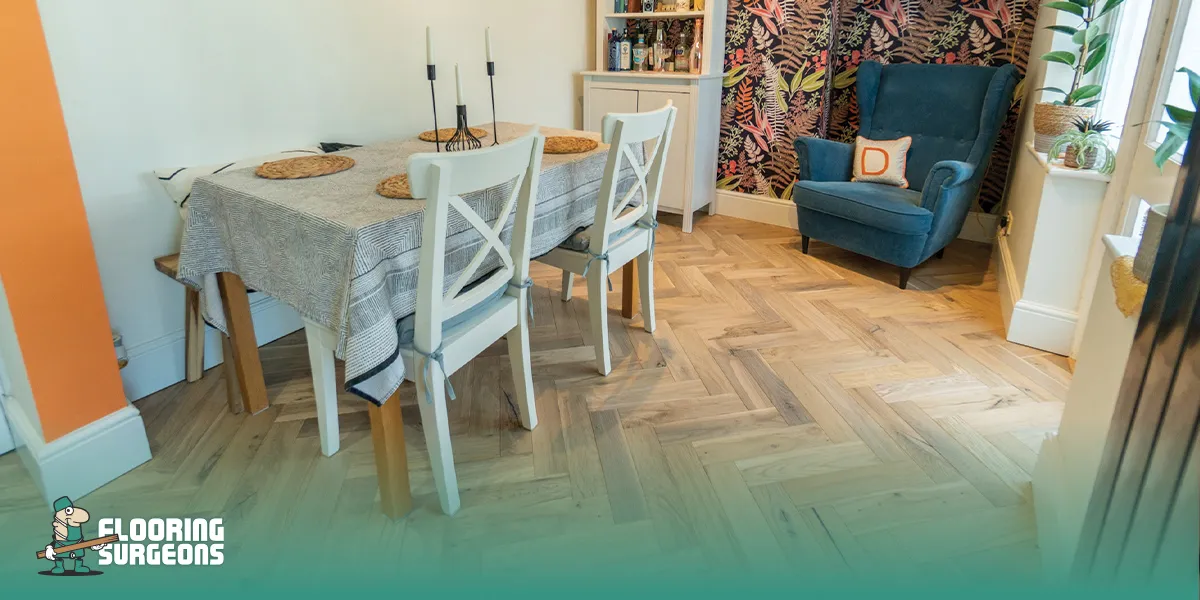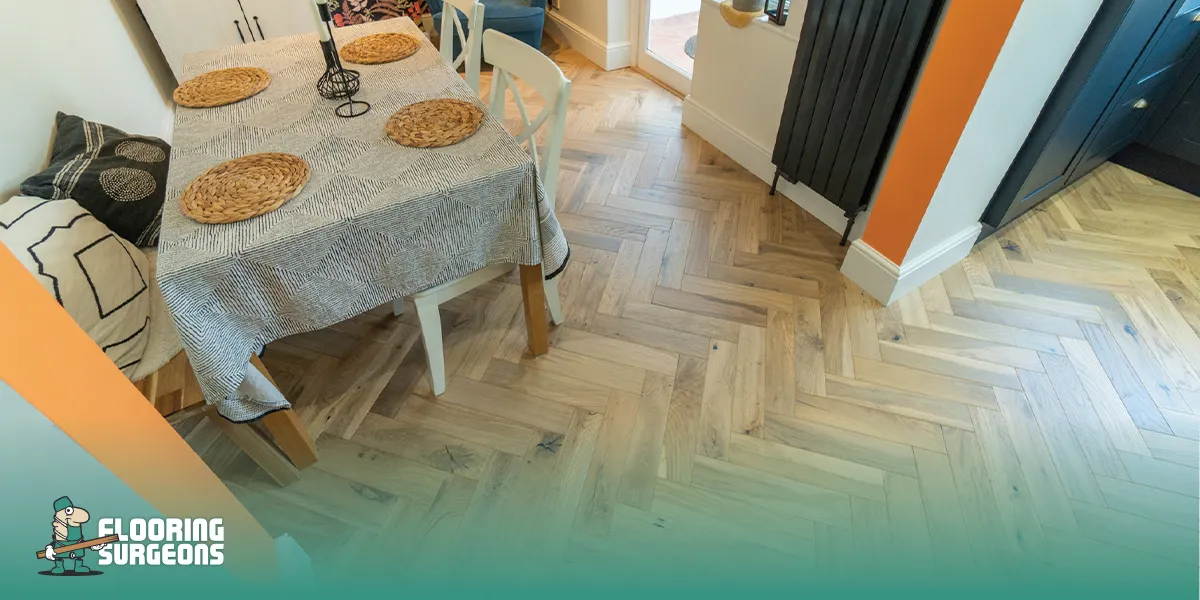Yes. Most modern engineered and luxury vinyl herringbone floors are fully compatible with underfloor heating systems. Their layered structures expand evenly, preventing warping or cracking under heat.
Engineered wood and luxury vinyl (LVT) are top choices. Engineered offers natural warmth and authentic texture, while vinyl provides faster heat transfer and total water resistance — ideal for busy kitchens.
Technically, yes, but not recommended. Solid wood reacts to temperature and humidity changes, often expanding and contracting too much. For heated kitchens, engineered herringbone is a safer and longer-lasting alternative.
Keep surface temperatures below 27°C (80°F). Higher heat can dry out the top layer or affect adhesives. A thermostat with a floor sensor helps maintain safe, consistent warmth.
Absolutely. Its multi-layer core provides structural stability, helping it resist the small expansions that occur when the heating system cycles on and off. It feels solid and stays silent underfoot.
Yes—and it’s one of the most energy-efficient options. Luxury vinyl’s compact design quickly and evenly transfers warmth, and it’s 100% waterproof — perfect for kitchens with frequent spills or steam.
The subfloor must be dry, level, and clean. Use a moisture barrier or underlay designed for underfloor heating. For electric systems, make sure wires are embedded in a thin self-levelling compound to ensure even heat distribution.
Not if installed correctly. Damage usually comes from excessive heat or poor subfloor preparation. With the right insulation layer and temperature control, herringbone floors stay perfectly stable.
Costs vary by material and area size. As a rough guide:
Simple care goes a long way. Use a soft vacuum or microfiber mop; avoid soaking the surface. Keep humidity between 40–60% and don’t suddenly overheat the system — let the warmth rise gradually to protect the flooring’s structure.
Many homeowners worry that the zigzag layout of herringbone might feel too “busy” or difficult to maintain in a kitchen full of life, cooking, spills, footsteps, and heat. But a well-engineered 10mm herringbone floor, properly finished and sealed, behaves quite the opposite. It absorbs visual clutter instead of adding to it, grounding the space with rhythm and balance. Explore our underfloor-heating-compatible herringbone collections; engineered, stable, and designed for real kitchens that don’t just look lived in, but loved in.

Because your kitchen isn’t just where food is made; it’s where life circulates.
Choosing a floor that handles heat, moisture, movement, and mess while still looking curated is no small task. Herringbone achieves that balance through both form and function.
Herringbone flooring works exceptionally well with underfloor heating thanks to its engineered stability, tight interlocking pattern, and efficient heat distribution. The multi-layer core of 10mm engineered herringbone expands gently with temperature changes, allowing heat to travel evenly across the surface without creating hotspots or cold patches. Its geometric layout enhances thermal flow, delivering faster warm-up times and a soft, consistent warmth underfoot, especially in open-plan kitchens where comfort matters most. Beyond performance, the pattern also adds visual depth, reduces glare, and hides everyday marks, making it both a practical and stylish companion for modern heating systems.
Each interlocking section of a properly engineered herringbone board sits flat and tight, allowing heat to move evenly across the entire surface. Unlike thick, solid planks that can trap warmth or laminate boards that separate under temperature shifts, 10mm engineered herringbone has a stable multilayer core that expands gently with heat rather than resisting it.
That means your kitchen warms up faster, cools down more slowly, and maintains an even temperature underfoot; perfect for open-plan layouts where the dining area connects directly to the kitchen.
A well-installed herringbone floor doesn’t just conduct heat; it translates it into comfort. The chevron geometry distributes warmth across the surface more uniformly, so you don’t get those cold “dead zones” you often feel with tile or stone floors.
Imagine stepping barefoot into your kitchen on a winter morning; instead of a shock of cold, you get a quiet, consistent warmth that follows you from the oven to the coffee machine. That’s not luxury; that’s innovative design that understands daily life.
People often assume that the herringbone pattern is too intricate for a kitchen that already has texture; appliances, lighting, tiles, and cabinets. But in practice, it works like visual therapy. Where a plain plank floor can feel flat or clinical, herringbone adds dimension without chaos. The repeating angles gently break up reflections from polished surfaces and metal fittings, softening the overall look.
And maintenance? Surprisingly easy. The pattern hides minor crumbs, dust, or watermarks better than straight boards do, because the light hits it from multiple directions. With a sealed surface, spills wipe clean before they ever have a chance to seep in.

| Material Type | Why It Works for Kitchens | Best For |
| Engineered Wood Herringbone (10mm–14mm) | The stable layered structure resists heat expansion and humidity; it is compatible with underfloor heating. | Modern family kitchens and open-plan dining areas. |
| Vinyl Herringbone / LVT | 100% waterproof; textured surface; ideal for heavy-use or rental properties. | Busy households, small flats, or kitchens near garden doors. |
| Hybrid Herringbone (SPC/WPC) | Combines a real wood look with a waterproof, rigid core; excellent under heat. | Homes wanting wood aesthetics without maintenance worry. |
| Solid Wood Herringbone | Visually stunning, but requires perfect humidity control; not ideal over heating systems. | Feature kitchens or low-humidity zones only. |
Not every herringbone floor is the same; the secret lies in the core and surface finish. Here’s a breakdown of which types work best and why:
Each material tells a different story:
Herringbone Flooring for the Kitchen brings order to what’s often the most chaotic room in the house. It balances warmth with design, elegance with practicality — and when paired with underfloor heating, it transforms your kitchen from a workspace into a living, breathing space of comfort.
Discover your ideal kitchen flooring; browse our Underfloor Heating Compatible Herringbone Collection and request free samples today from Flooring Surgeons.
Not every herringbone floor behaves the same way when heat is introduced.
The key to getting both warmth and long-term performance is understanding how each flooring type responds to temperature, moisture, and wear. Some look luxurious but struggle in changing heat; others conduct heat beautifully but trade a little realism.
Here’s a clear, side-by-side look at which herringbone materials truly deliver underfloor heating compatibility, and which ones demand more care.
| Flooring Type | UFH Compatibility | Heat Transfer | Durability (Average Lifespan) | Cost Level |
| Engineered Wood Herringbone | Excellent – stable multi-layer structure resists warping under heat | High–efficiency thermal conductivity due to balanced density | 20–30 years with proper care | Medium–High |
| Luxury Vinyl Herringbone (LVT) | Excellent – 100% waterproof and heat-safe | Very High – thin profile ensures quick surface heating | 15–25 years, depending on wear layer | Medium |
| Laminate Herringbone | Good – suitable for low to medium heat settings | Medium – slight delay in heat distribution | 10–15 years average | Low–Medium |
| Solid Wood Herringbone | Poor – expands and contracts under changing heat | Low–density profile slows heat transfer | 30+ years, but needs perfect climate control | High |
What the Comparison Really Means
If your kitchen or living area has underfloor heating, the safest and most innovative options are engineered wood and luxury vinyl (LVT) herringbone floors.
Meanwhile, laminate can be a budget-friendly choice if your heating system runs at lower temperatures, though it won’t deliver the same comfort or long-term feel.
And, despite its beauty, solid wood is the least forgiving under radiant heat. The dense timber expands and contracts too much, which can cause small gaps or lifted edges over time. It’s better suited for traditional homes without underfloor heating.
Picture this: In a modern open-plan kitchen, you’ve got a breakfast island, soft LED lighting, and underfloor heating that hums quietly below.
If you lay engineered herringbone flooring, the heat flows naturally through the boards — every corner stays warm and balanced, and the pattern reflects the morning light like woven fabric. But if you’d used solid oak herringbone instead, the boards might start to shift slightly near the oven area after a few seasons, needing refinishing or adjustment. That’s why the structure beneath the beauty matters just as much as the pattern itself.
If your kitchen or hallway has underfloor heating, go for:
Both are designed to perform beautifully under pressure — of heat, movement, and life. Explore our full range of underfloor-heating-compatible herringbone flooring and order free samples to feel the difference yourself; only at Flooring Surgeons.

Your kitchen deserves a flooring that doesn’t just survive heat — it thrives in it. Whether you want the warm character of engineered wood flooring, the practicality of luxury vinyl, or the reliability of laminate flooring, every option in our Herringbone for Underfloor Heating collection is designed to balance beauty, comfort, and performance.
Our experts can help you match the right flooring to your heating setup — from water-based (wet) systems to electric mats — ensuring your installation stays stable, efficient, and safe.
Browse the whole collection, request free samples, or speak directly with our flooring specialists for tailored advice on fitting herringbone floors that look stunning and feel just right underfoot. Because when heating meets design, the kitchen becomes the warmest heart of your home.